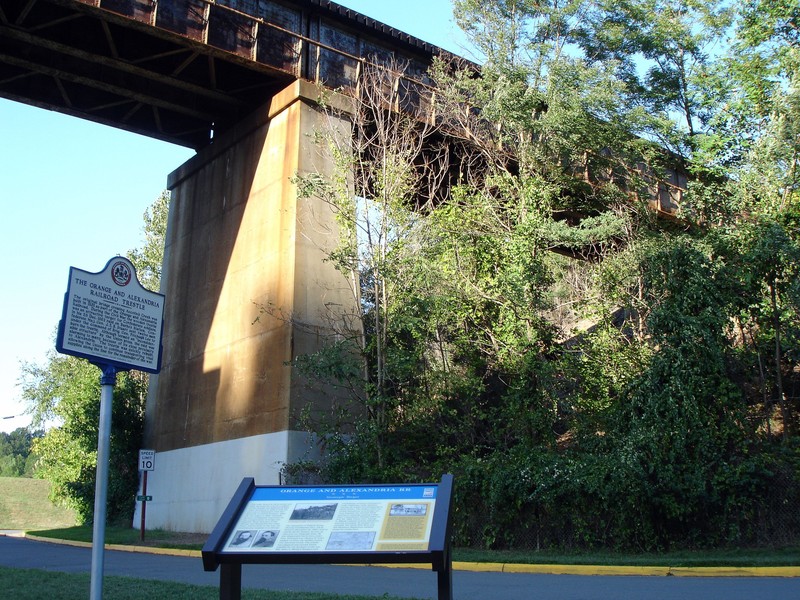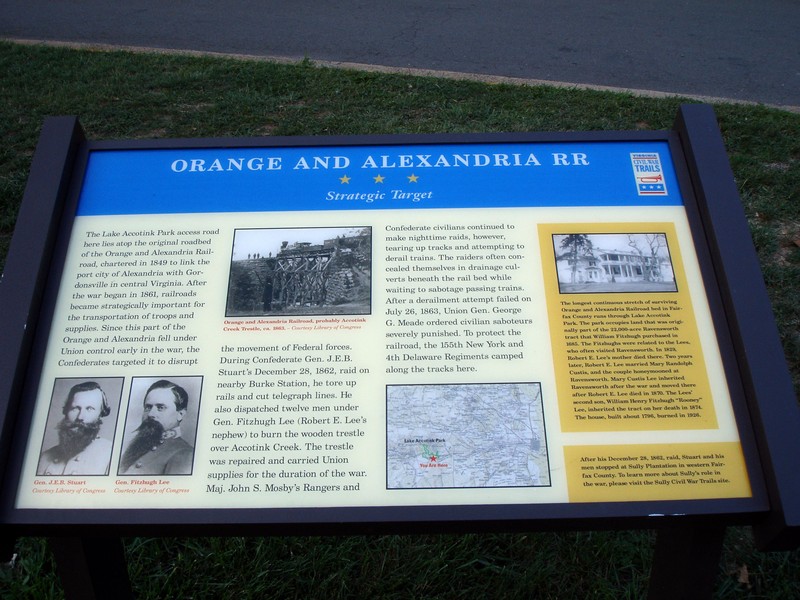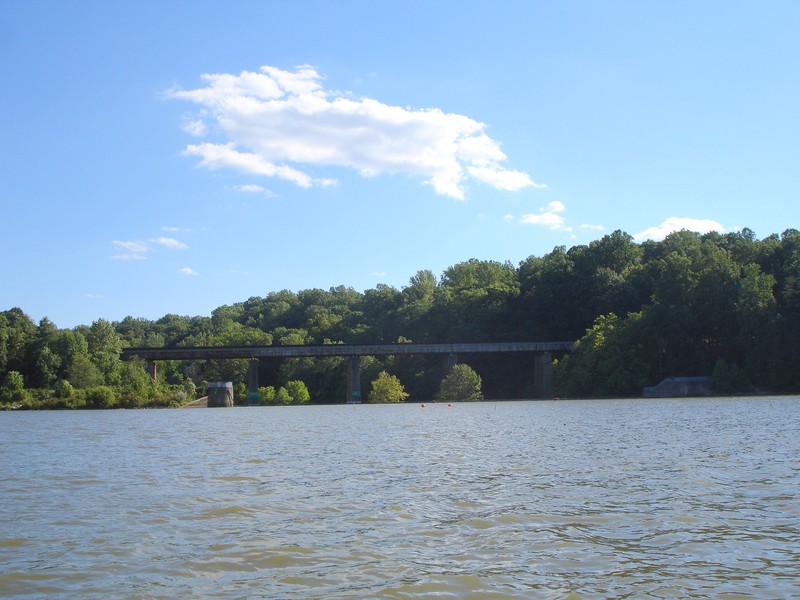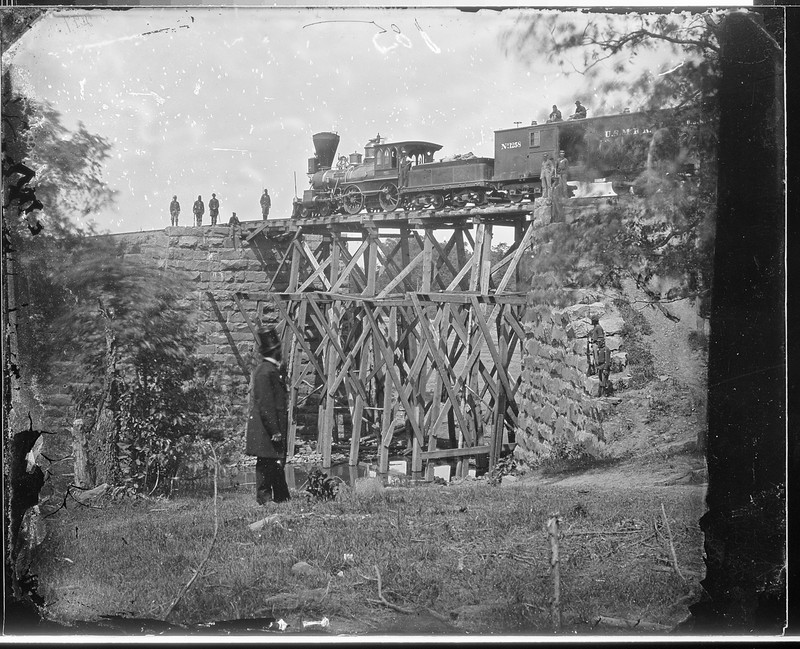The Orange and Alexandria Railroad Trestle at Accotink Creek
Introduction
Text-to-speech Audio
Images
Accotink Bridge historical markers in front of the modern bridge

"Orange and Alexandria RR: Strategic Target" Civil War Trails marker near the modern bridge

Lake Accotink, the dam, and the modern bridge

This picture is widely reported as being of the original Accotink Bridge, and it is included on several markers. However, other sources dispute the claim. The picture, taken by Matthew Brady or one of his associates, is simply labeled "Cars of U.S. Military R. R., and bridge built by Soldiers. Orange and Alexandria R. R." by the National Archives.

Backstory and Context
Text-to-speech Audio
The original, wooden trestle over Accotink Creek was constructed most likely using slave labor for the Orange and Alexandria Railroad. The railroad had been chartered in 1848 to connect Alexandria with the Virginia Central Railroad in Gordonsville, which it reached in March 1853. By 1860, it stretched to Lynchburg, where it tied in with the Virginia and Tennessee Railroad. It grew the communities along its route and was important in the development of northern Virginia. It also became an important strategic target during the Civil War—battles were fought near Manassas Junction and Bristoe and Brandy Stations. The railroad’s Alexandria office was seized on May 29th, 1861, the day after Virginia’s secession; however, the Confederates still managed to take most of the rolling stock. The Union put much of the rest of the railroad under the US Military Railroad System.
The most famous action at the bridge was during General J.E.B. Stuart’s Christmas Raid of 1862. Stuart and his men had raided Dumfries and Occoquan, then crossed the Occoquan River on December 27th, 1862, and headed towards Burke’s Station. Most of the logistical forces in the area had been pulled back to Fairfax Courthouse (now Fairfax City) in anticipation of Stuart’s raid. However, two trains were still in the area; J.A. Flagg, the telegrapher at Burke’s Station, was warned that Stuart’s forces were only a few miles away and forwarded this warning to the two conductors, who were able to take their trains back across the Accotink Bridge and to Alexandria just in time. Stuart successfully took Burke’s Station around seven o’clock in the evening on December 28th. Shortly thereafter, he sent Brigadier General Fitzhugh Lee (Robert E. Lee’s nephew), Surgeon John B. Fontaine, Lieutenant John Lee, and ten men to burn the bridge over Accotink Creek. They did, but, according to Union reports, the “inconsiderable structure” was not significantly damaged and was easily repaired.[8] While on their way to rendezvous with the main force at the Little River Turnpike, General Lee’s band captured one Union lieutenant and three men.
The bridge was used by the Union, and targeted by the Confederacy, for the rest of the war. Major John S. Mosby’s Rangers and local civilians were known to hide in the culverts under the rail bed before tearing up tracks or attempting to derail passing trains. The 155th New York and 4th Delaware were eventually stationed there to protect the strategically vital railroad.
After the war, the railroad was in serious disrepair. It ended up passing under control of the Baltimore and Ohio Railroad in 1873, then the Southern Railway in 1894. Southern moved the tracks in the early 1900s and built a new, iron bridge in 1917. In 1918, the US Army Corps of Engineers built “Springfield Dam” on Accotink Creek to supply water to the new base at Camp A.A. Humphreys (now Fort Belvoir). It created a 110-acre, 23-foot-deep lake. However, the dam was torn out in 1922 after it was revealed that it was threatening the railroad bridge. Another dam was built in 1943.
The land was purchased by the Fairfax County Park Authority in 1965. Today, it is the site of the 493-acre Lake Accotink Park, which offers all kinds of outdoor activities, including hiking, boating, picnicking, mini golf, volleyball, basketball, camps and classes, and nature programs, as well as a carousel.
The modern bridge was built out of concrete and steel sometime after the 1917 bridge. It is still owned by what is now the Norfolk Southern Railway, but it is used by the Virginia Railway Express and Amtrak. While the current bridge stands in approximately the same location as the original, the tracks sat on what is now Lake Accotink Road and the Lake Accotink trail. Many of the culverts, mentioned above as sites for Confederate ambushes, still survive under the road and trail and can be explored. One of the culverts was replaced by the Fairfax County Park Authority in 2017 after an archaeological excavation, which discovered two pieces of the original track in addition to documenting the original stones of the culvert.
Sources
1) 150th anniversary of the raid at Accotink and Burke commemorated, the Annandale Blog. December 31st 2012. Accessed June 24th 2020. https://annandaleva.blogspot.com/2012/12/150th-anniversary-of-raid-at-accotink.html.
2) Burke Centre, VA (BCV), The Great American Stations. Accessed June 24th 2020. https://www.greatamericanstations.com/stations/burke-centre-va-bcv/.
3) Doyle, Brian. Back in the Day: Burke Station Raid, Patch: Burke, VA. October 27th 2010. Accessed June 24th 2020. https://patch.com/virginia/burke/burke-station-raid.
4) Fairfax County Park Authority. Lake Accotink Park; Park Authority, Fairfax County Virginia. Accessed June 24th 2020. https://www.fairfaxcounty.gov/parks/lake-accotink.
5) Fairfax County Park Authority. Orange and Alexandria Railroad; ArtiFACTS; Park Authority, Fairfax County Virginia. Accessed June 24th 2020. https://www.fairfaxcounty.gov/parks/artifacts/orange-alexandria-railroad.
6) Markers and Information, Historical Lake Accotink Park. Accessed June 24th 2020. https://vaaccotink.weebly.com/markers.html.
7) Orrison, Rob. “…please furnish better mules…”— JEB Stuart’s 1862 Christmas Raid, Part One, Emerging Civil War. December 26th 2014. Accessed June 24th 2020. https://emergingcivilwar.com/2014/12/26/please-furnish-better-mules-jeb-stuarts-1862-christmas-raid/.
8) Prats, J. J. The Orange And Alexandria Railroad Trestle, HMdb.org. August 27th 2019. Accessed June 24th 2020. https://www.hmdb.org/m.asp?m=38.
9) Prats, J. J. Orange and Alexandria RR: Strategic Target, HMdb.org. June 16th 2016. Accessed June 24th 2020. https://www.hmdb.org/m.asp?m=2749.
10) Prats, J. J. The Origins of Lake Accotink, HMdb.org. June 8th 2018. Accessed June 24th 2020. https://www.hmdb.org/m.asp?m=7141.
11) Scott, Robert N. Lazelle, Henry M. The War of the Rebellion: A Compilation of the Official Records of the Union and Confederate Armies. Series I. Volume XXI. Washington, DC. Government Printing Office, 1888. Cornell University on HathiTrust Digital Library. January 12th 2018. Accessed June 24th 2020. https://hdl.handle.net/2027/coo.31924077723017?urlappend=%3Bseq=3. p. 734.
12) Swain, Craig. Orange and Alexandria Railroad, HMdb.org. August 27th 2019. Accessed June 24th 2020. https://www.hmdb.org/m.asp?m=37511.
13) Vrana, John. Lipsey, Mary. Stuart's Christmas Raid: Burke, Virginia: Dec. 28, 1862, Fairfax Station Railroad Museum. November 11th 2013. Accessed June 24th 2020. https://fairfax-station.org/pdfs/Stuart%20raid.pdf.
HMdb.org (https://www.hmdb.org/PhotoFullSize.asp?PhotoID=7711)
HMdb.org (https://www.hmdb.org/PhotoFullSize.asp?PhotoID=7709)
HMdb.org (https://www.hmdb.org/PhotoFullSize.asp?PhotoID=7712)
National Archives and Records Administration - Public Domain (https://catalog.archives.gov/id/524604)
